_-_%C2%ABStop%C2%BB_(%C2%A1ah%5E)_-_panoramio.jpg.webp)
.jpg.webp)
Road signs in Cuba are regulated in Ley No. 109 Código de Seguridad Vial and generally conform to the 1968 Vienna Convention on Road Signs and Signals.[1][2]
Road signs in Cuba generally use the same pattern of colors, shapes, and symbols as set out in the Vienna Convention on Road Signs and Signals, which are used in most European countries. Cuba is the only signatory to the Vienna Convention on Road Signs and Signals among the countries of the Caribbean. Cuba drives on the right.
Warning signs (Group A)
Unlike most countries in the Americas (United States, Canada, Mexico and Latin American countries) that use diamond-shaped warning signs on a yellow background based on the MUTCD, warning signs in Cuba are triangular in shape with a red border and a yellow background, similar to those used in Greece, Poland, Sweden, Vietnam, and Finland.
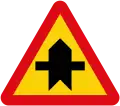 Intersection with priority
Intersection with priority Intersection with priority
Intersection with priority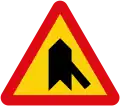 Intersection with priority
Intersection with priority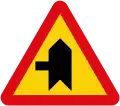 Intersection with priority
Intersection with priority Intersection with priority
Intersection with priority Intersection
Intersection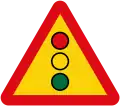 Traffic lights
Traffic lights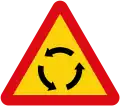 Roundabout
Roundabout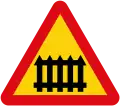 Level crossing ahead (with gates)
Level crossing ahead (with gates)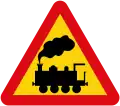 Level crossing ahead (without gates)
Level crossing ahead (without gates)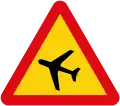 Low-flying aircraft
Low-flying aircraft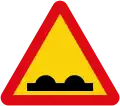 Uneven road
Uneven road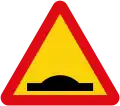 Speed bump
Speed bump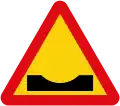 Dip
Dip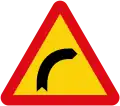 Curve to the right
Curve to the right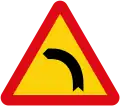 Curve to the left
Curve to the left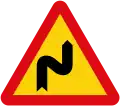 Double curve, or a series of curves, the first to the right
Double curve, or a series of curves, the first to the right Double curve, or a series of curves, the first to the left
Double curve, or a series of curves, the first to the left Steep descent
Steep descent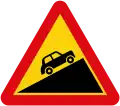 Steep ascent
Steep ascent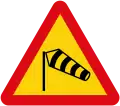 Wind
Wind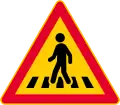 Pedestrian crossing - option 1
Pedestrian crossing - option 1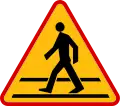 Pedestrian crossing - option 2
Pedestrian crossing - option 2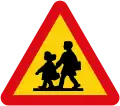 Children
Children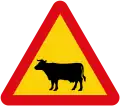 Animals (domesticated)
Animals (domesticated)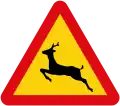 Animals (wild)
Animals (wild)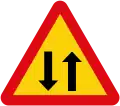 Two-way traffic
Two-way traffic Falling rocks
Falling rocks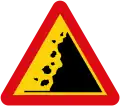 Falling rocks
Falling rocks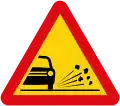 Loose gravel
Loose gravel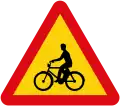 Cyclists
Cyclists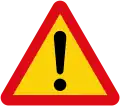 Danger
Danger Countdown beacon
Countdown beacon Countdown beacon
Countdown beacon Countdown beacon
Countdown beacon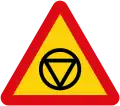 Stop ahead
Stop ahead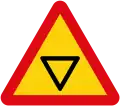 Give way ahead
Give way ahead
Priority signs (Group B)
Unlike most countries in the world that use an octagonal stop sign, Cuba still uses a circular stop sign with a red inverted triangle and it is defined in the Vienna Convention on Road Signs and Signals as B2b. This convention still allows an older style of stop sign.
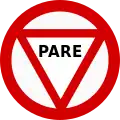
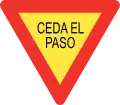 Give way
Give way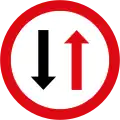 Priority for oncoming traffic
Priority for oncoming traffic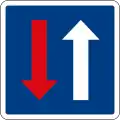 Priority over oncoming traffic
Priority over oncoming traffic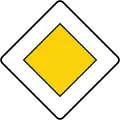 Priority road
Priority road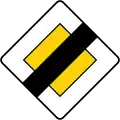 End of priority road
End of priority road Turn right on red light
Turn right on red light Go straight on red light
Go straight on red light Turn left on green light
Turn left on green light
Prohibitory signs (Group C)
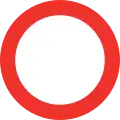 Closed to all vehicles in both directions
Closed to all vehicles in both directions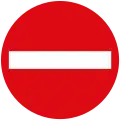 No entry
No entry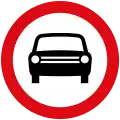 No entry for any power driven vehicle, except two-wheeled motorcycles without sidecar
No entry for any power driven vehicle, except two-wheeled motorcycles without sidecar No entry for motorcycles
No entry for motorcycles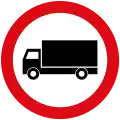 No entry for goods vehicles
No entry for goods vehicles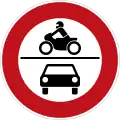 No entry for power driven vehicles
No entry for power driven vehicles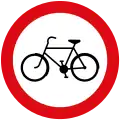 No entry for cycles
No entry for cycles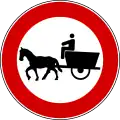 No entry for animal-drawn vehicles
No entry for animal-drawn vehicles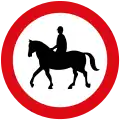 No horse riding
No horse riding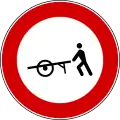 No entry for handcarts
No entry for handcarts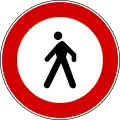 No entry for pedestrians
No entry for pedestrians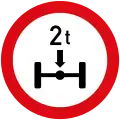 No entry for vehicles having a mass exceeding ... tonnes on one axle
No entry for vehicles having a mass exceeding ... tonnes on one axle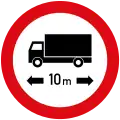 No entry for vehicles or combinations of vehicles exceeding ... metres in length
No entry for vehicles or combinations of vehicles exceeding ... metres in length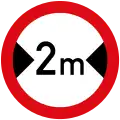 No entry for vehicles having an overall width exceeding ... metres
No entry for vehicles having an overall width exceeding ... metres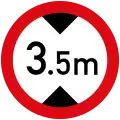 No entry for vehicles having an overall height exceeding ... metres
No entry for vehicles having an overall height exceeding ... metres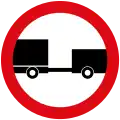 No entry for any power driven vehicle drawing a trailer, except semi-trailers or single axle trailers
No entry for any power driven vehicle drawing a trailer, except semi-trailers or single axle trailers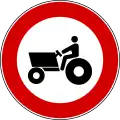 No entry for power driven agricultural vehicles
No entry for power driven agricultural vehicles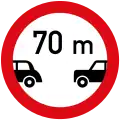 Driving of vehicles less than ... metres apart prohibited
Driving of vehicles less than ... metres apart prohibited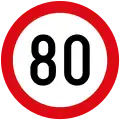 Maximum speed limit
Maximum speed limit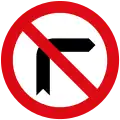 No right turn
No right turn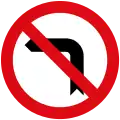 No left turn
No left turn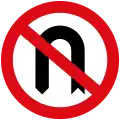 No U-turn
No U-turn Overtaking prohibited
Overtaking prohibited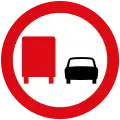 Overtaking by goods vehicles prohibited
Overtaking by goods vehicles prohibited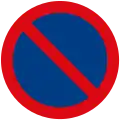 Parking prohibited
Parking prohibited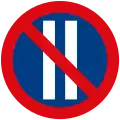 Parking prohibited on odd days: the parking prohibition applies only on odd days on the side of the road where the sign is locate
Parking prohibited on odd days: the parking prohibition applies only on odd days on the side of the road where the sign is locate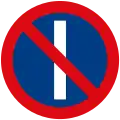 Parking prohibited on even days: the parking prohibition applies only on even days on the side of the road where the sign is located
Parking prohibited on even days: the parking prohibition applies only on even days on the side of the road where the sign is located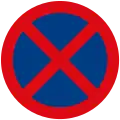 Stopping and parking prohibited
Stopping and parking prohibited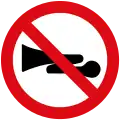 Use of audible warning devices prohibited
Use of audible warning devices prohibited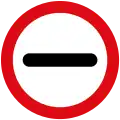 Passing without stopping prohibited
Passing without stopping prohibited
Mandatory signs (Group D)
Mandatory signs are on a blue background with white symbols as defined in Type A of the Vienna Convention on Road Signs and Signals, which is used in almost all countries of Europe, Asia (except for Pakistan and Sri Lanka) and Africa, as well as New Zealand.
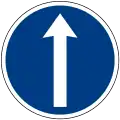 Go straight ahead
Go straight ahead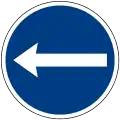 Turn left
Turn left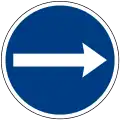 Turn right
Turn right Turn left
Turn left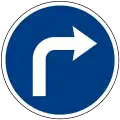 Turn right
Turn right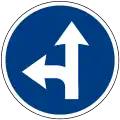 Go straight or turn left
Go straight or turn left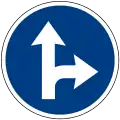 Go straight or turn right
Go straight or turn right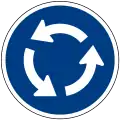 Roundabout
Roundabout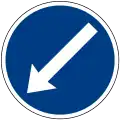 Pass on the left
Pass on the left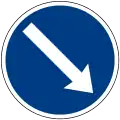 Pass on the right
Pass on the right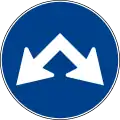 Pass on either side
Pass on either side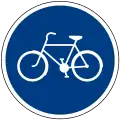 Cycle path
Cycle path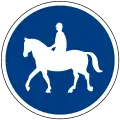 Horse riding track
Horse riding track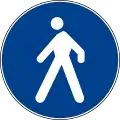 Footpath
Footpath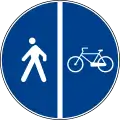 Cycle path and footpath
Cycle path and footpath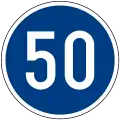 Minimum speed limit
Minimum speed limit Trucks only
Trucks only Buses only
Buses only Headlamps turn on
Headlamps turn on
De-restriction signs (Group E)
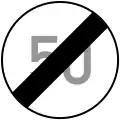 End of the maximum speed limit
End of the maximum speed limit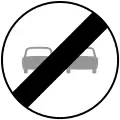 End of the overtaking prohibition
End of the overtaking prohibition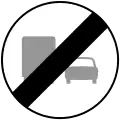 End of the overtaking prohibition for goods vehicles
End of the overtaking prohibition for goods vehicles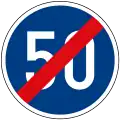 End of the minimum speed limit
End of the minimum speed limit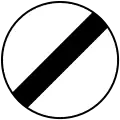 End of all local prohibitions imposed on moving vehicles
End of all local prohibitions imposed on moving vehicles End of cycle path
End of cycle path End of footpath
End of footpath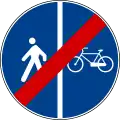 End of cycle path and footpath
End of cycle path and footpath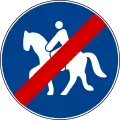 End of horse riding track
End of horse riding track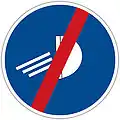 Headlamps turn off
Headlamps turn off
Information sign (Group F)
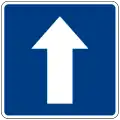 One-way traffic
One-way traffic One-way traffic
One-way traffic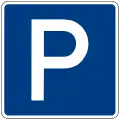 Parking
Parking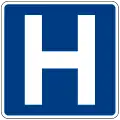 Hospital
Hospital Motorway
Motorway End of motorway
End of motorway Road for motor vehicles
Road for motor vehicles End of road for motor vehicles
End of road for motor vehicles Bus stop
Bus stop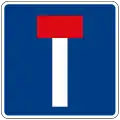 No through road
No through road First aid station
First aid station Public telephone
Public telephone Breakdown service
Breakdown service Filling station
Filling station Restaurant
Restaurant Cafeteria
Cafeteria Hotel or motel
Hotel or motel Starting point for walks
Starting point for walks Place equipped for excursions
Place equipped for excursions Camping site
Camping site Caravan site
Caravan site Camping and caravan site
Camping and caravan site Youth hostel
Youth hostel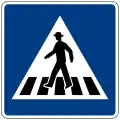 Pedestrian crossing (with zebra stripes)
Pedestrian crossing (with zebra stripes)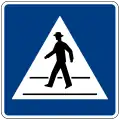 Pedestrian crossing (through two parallel lines)
Pedestrian crossing (through two parallel lines)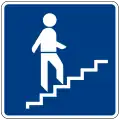 Pedestrian overpass
Pedestrian overpass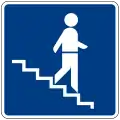 Pedestrian underpass
Pedestrian underpass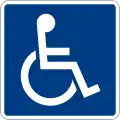 Parking place for handicapped persons
Parking place for handicapped persons Emergency telephone
Emergency telephone
Orientation signs (Group G)
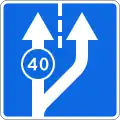 Start of extra lane with minimum speed limit
Start of extra lane with minimum speed limit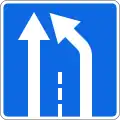 End of extra lane
End of extra lane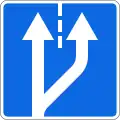 Start of extra lane
Start of extra lane Advance direction sign for route to be followed to turn left, where a left turn at the next intersection is prohibited
Advance direction sign for route to be followed to turn left, where a left turn at the next intersection is prohibited Distance to...
Distance to... Length of...
Length of... Time of action
Time of action Side extension (of parking or stopping ban)
Side extension (of parking or stopping ban) Side extension (of parking or stopping ban)
Side extension (of parking or stopping ban) Side extension (of parking or stopping ban)
Side extension (of parking or stopping ban) Only road user category shown (semi-trailer trucks)
Only road user category shown (semi-trailer trucks) Direction of priority road
Direction of priority road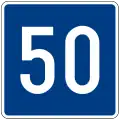 Advisory speed
Advisory speed
References
- ↑ Ley No. 109 Código de Seguridad Vial (PDF) (in Spanish). La Habana, Cuba: Ministerio de Justicia. 2016.
- ↑ "Vienna Convention on Road Signs and Signals – unece" (PDF). United Nations Economic Commission for Europe (UNECE). UNITED NATIONS. Retrieved 12 July 2018.